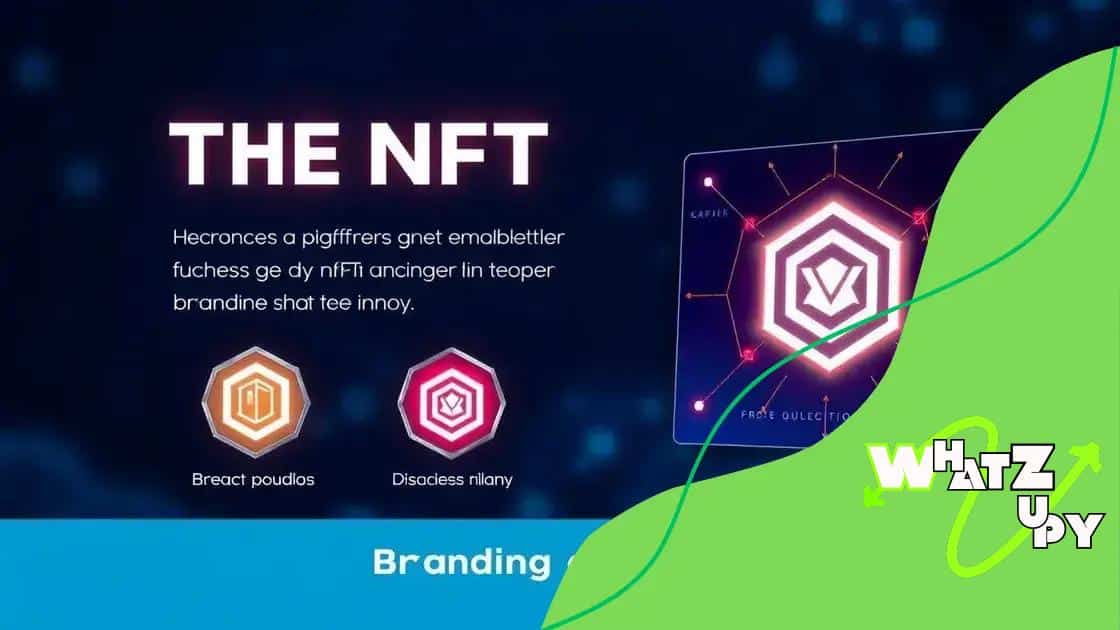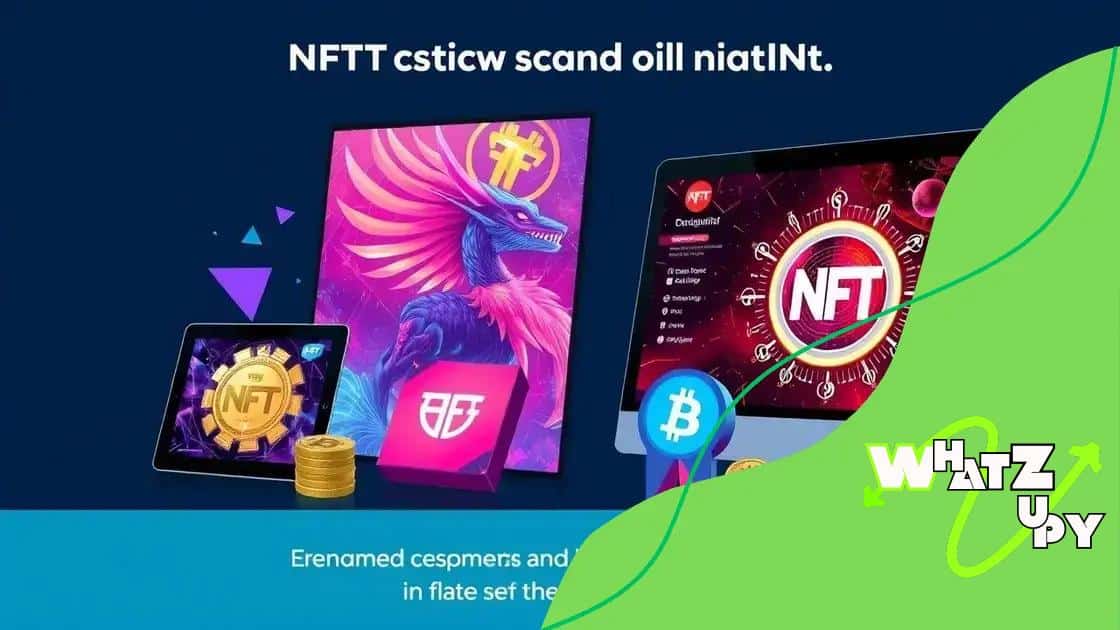How NFTs are revolutionizing brand engagement

How NFTs are revolutionizing brand engagement by providing unique opportunities for customer connection, enhanced loyalty, and innovative marketing strategies, despite challenges like market volatility and regulatory issues.
How NFTs are revolutionizing brand engagement is changing the way companies connect with their audiences. Imagine a world where brands can create unique experiences that foster loyalty and engagement—this is the promise of NFTs.
Understanding NFTs and their significance
NFTs, or non-fungible tokens, represent a significant leap in the digital world. They are unique digital items verified using blockchain technology, allowing ownership and authenticity to be clearly established. This innovation has opened doors to new opportunities for brands and creators alike.
Understanding NFTs is essential, as they fundamentally alter the way we perceive ownership and value in the digital space. With NFTs, artists can sell their work directly to consumers without intermediaries, leading to greater profits and control.
Key Features of NFTs
Several key features make NFTs compelling:
- Uniqueness: Each NFT has a distinctive value and cannot be exchanged on a one-to-one basis.
- Ownership: Blockchain technology ensures clear ownership rights.
- Transferability: NFTs can be easily bought, sold, or traded on various platforms.
- Interactivity: Some NFTs allow for community engagement, enhancing their significance.
The significance of NFTs goes beyond just digital art. Brands can utilize these tokens to create exclusive merchandise, reward loyal customers, and foster deeper connections. Imagine a brand releasing limited edition NFTs that give owners access to special events or promotions. This transforms customer engagement into a more interactive experience.
As businesses explore the possibilities of NFTs, they offer creative ways to enhance engagement strategies. Brands can leverage the uniqueness of NFTs to tell their stories in new and engaging ways, fostering loyalty and community among their audience. Innovations like branded virtual collectibles can form lasting emotional connections that traditional marketing methods struggle to achieve.
Investing in NFTs isn’t just about the future of ownership, but also the evolution of how brands communicate and build relationships with their audiences. While there are challenges in this emerging market, the potential rewards for brand engagement make NFTs a worthy consideration for many companies.
Ways brands incorporate NFTs
Brands are increasingly finding innovative ways to incorporate NFTs into their marketing strategies. By leveraging these unique digital assets, companies can create deeper connections with their audiences. The versatility of NFTs extends beyond simple collectibles; they can facilitate exclusive access, grow customer loyalty, and enhance overall brand experience.
Exclusive Merchandise and Events
One popular method is creating exclusive merchandise that can only be purchased through NFT ownership. This allows brands to offer something unique, driving demand. Brands can also host special events or experiences for NFT holders, adding significant value.
- Limited edition products: Items that can only be bought with NFTs.
- Access to events: Private gatherings or virtual meet-and-greets.
- Special promotions: Discounts or pre-sales exclusive to NFT owners.
Furthermore, brands can use NFTs to reward their most loyal customers. By providing tokens to frequent buyers, businesses can encourage repeat purchases. These tokens may grant perks, like early access to new products or invitations to exclusive events. Over time, this strategy fosters a devoted community.
Another exciting avenue is gamification. Brands can create engaging experiences by integrating NFTs into games or interactive digital environments. Users can earn or purchase NFTs that offer unique functionalities or enhancements in the game. This interactivity captivates audiences, making their engagement with the brand more significant.
Collaborations and Partnerships
Collaborating with artists and influencers is another strategy for brands to incorporate NFTs. By partnering with well-known figures, brands can increase visibility and reach new audiences. Such collaborations can result in unique digital art pieces or collectibles that resonate with fans.
Ultimately, as brands explore different ways to utilize NFTs, they unlock creative ideas that enrich customer engagement and drive innovation. These methods not only elevate the consumer experience but also solidify the brand’s position in a competitive market.
Benefits of using NFTs for engagement

Using NFTs for engagement offers numerous benefits for brands looking to enhance their connection with customers. These digital tokens allow for unique interactions that traditional methods simply cannot replicate. This unique approach is changing how brands communicate and build loyalty.
Enhanced Customer Experience
One of the main benefits is the enhanced customer experience. With NFTs, brands can create exclusive content or experiences tailored to individual customers. Imagine owning a digital art piece that also grants you access to a private gallery showing or a virtual event.
- Personalized rewards: Customers can receive tailored benefits linked to their NFT ownership.
- Exclusive content: Owners can access behind-the-scenes content that enhances their connection to the brand.
- Gamification: Integrating NFTs into games can make engagement more interactive and fun.
Additionally, using NFTs can significantly boost brand loyalty. When customers invest in a brand through digital collectibles, they feel a deeper emotional connection. This ties back to the unique ownership aspect of NFTs. A customer who owns a limited edition NFT is more likely to return to the brand for future purchases.
Increased Visibility and Reach
Another notable advantage is the increased visibility brands gain by using NFTs. When a brand launches an NFT, it often garners attention from both fans and the media. The buzz surrounding an NFT drop can significantly amplify a brand’s reach, drawing in new audiences who may not have been familiar with the brand before.
Moreover, NFTs encourage customer discussions on social media platforms. People enjoy sharing unique digital items with their networks, which helps to organically promote the brand. This can lead to a wider audience and potentially more customers.
As brands continue to explore the benefits of NFTs, they redefine customer engagement and interaction methodologies. The unique possibilities offered by these digital assets enable brands to build vibrant communities around their products.
Case studies of successful NFT campaigns
Examining case studies of successful NFT campaigns can provide valuable insights into how brands have effectively harnessed this technology to engage audiences. These campaigns illustrate innovative strategies and highlight the potential of NFTs to enhance brand loyalty and awareness.
Top Examples of Successful Campaigns
One standout example is the digital artist Beeple, who sold an NFT artwork for an astonishing $69 million at Christie’s auction. This sale not only showcased the value of NFTs in the art world but also captured the attention of mainstream media, introducing a broader audience to digital assets.
- Exceptional reach: The high-profile sale engaged both collectors and casual observers, demonstrating the viral potential of NFTs.
- Value perception: It altered the traditional views on digital art ownership and pricing.
- Media buzz: The coverage sparked discussions about the future of art and technology.
Another prominent case is the NBA Top Shot platform, which allows fans to buy, sell, and trade officially licensed highlights as NFTs. This platform has generated substantial revenue and fostered a vibrant community of sports enthusiasts.
The success of NBA Top Shot highlights the appeal of collectible moments in sports. Fans can own unique clips, creating a sense of connection with their favorite players and teams. People are drawn to the thrill of collecting something that encapsulates a memorable moment.
Innovative Approaches
Similarly, the fashion brand Gucci partnered with the virtual world platform Roblox to launch a limited collection of digital sneakers as NFTs. This campaign reached younger audiences who are increasingly interested in virtual fashion and gaming.
Through this initiative, Gucci effectively engaged with a demographic that values unique and expressive digital identities. The campaign demonstrates how NFTs can successfully intersect with pop culture and fashion, creating exciting opportunities for brands.
Overall, these case studies reveal that the strategic use of NFTs can lead to explosive growth in brand visibility, customer engagement, and loyalty. As brands continue exploring the potential of NFTs, these examples serve as inspiration for future campaigns and innovation.
Challenges and future of NFTs in branding
The adoption of NFTs in branding comes with a mix of exciting opportunities and notable challenges. As brands explore the potential of these digital assets, they must navigate the complexities of this innovative landscape. Understanding these challenges is crucial for successful implementation in marketing strategies.
Challenges in Adoption
One significant challenge is the volatile nature of the NFT market. Prices can fluctuate dramatically, causing uncertainty for brands looking to invest. Companies may hesitate to commit resources if they are unsure about the long-term stability of NFTs.
- Market volatility: Sudden changes in NFT prices can cause financial risks.
- Regulatory issues: The legal landscape surrounding NFTs is still evolving, leading to potential compliance hurdles.
- Environmental concerns: The energy consumption associated with blockchain technology raises sustainability questions.
- Consumer education: Many consumers are still unfamiliar with NFTs, making it critical for brands to educate their audiences.
Another challenge is fostering genuine engagement. With many brands jumping on the NFT bandwagon, standing out in a crowded market can be difficult. To achieve meaningful connections, brands must create unique, valuable experiences for their audiences.
The Future of NFTs in Branding
Despite these challenges, the future of NFTs in branding is promising. As more brands successfully integrate NFTs into their strategies, the potential for innovation increases. We may see the emergence of new use cases that enhance customer engagement and loyalty.
Future possibilities include more interactive experiences where NFTs serve as gateways to exclusive events or personalized content. Brands could create virtual worlds or experiences that combine shopping with immersive storytelling, allowing customers to engage with the brand like never before.
As technology continues to evolve, smart contracts can enhance the way brands leverage NFTs to facilitate transactions and rights management. This will also address some of the regulatory challenges and environmental concerns that currently exist.
In conclusion, while there are hurdles to overcome, the future of NFTs in branding holds great potential. Brands that adapt and innovate will set the groundwork for creating deeper connections with consumers in this digital age.
In summary, NFTs are changing how brands engage with their audiences. They offer unique opportunities for connection, loyalty, and innovation. While challenges exist, businesses that embrace NFTs can create exciting experiences that resonate with consumers. As this technology evolves, it is essential to stay informed and adapt strategies accordingly. The future of branding with NFTs is bright, and those who leverage this potential will likely stand out in today’s competitive landscape.
FAQ – Frequently Asked Questions About NFTs in Branding
What are NFTs?
NFTs, or non-fungible tokens, are unique digital assets stored on a blockchain that represent ownership of specific items or content.
How can brands use NFTs to engage customers?
Brands can use NFTs to create exclusive content, reward loyal customers, and offer unique experiences that enhance customer connection.
What are some challenges brands face with NFTs?
Challenges include market volatility, regulatory issues, and the need for consumer education with NFTs.
What does the future look like for NFTs in branding?
The future is promising, with potential for innovative uses that enhance customer interactions and create new marketing strategies.





